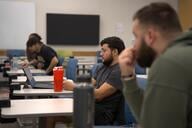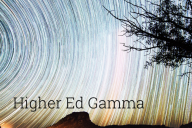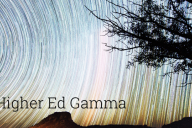You have /5 articles left.
Sign up for a free account or log in.
William Faulkner’s complex treatment of race in his novels and short stories contrasts starkly with his more simplistic, reductive and, at times, racist personal views. His fiction offers a far more empathetic and nuanced exploration of race than his personal views would suggest. His private letters and conversations lagged far behind his artistic insights.
This paradox—between the personal and the literary—is not, of course, unique to Faulkner.
Joseph Conrad’s Heart of Darkness is a profound critique of imperialism and its dehumanizing effects. However, his personal letters and some of his other writings reveal views that are considered racist by modern standards. His novel explores the psychological and moral complexities of colonialism, surpassing the simplicity of his personal opinions.
T.S. Eliot’s poetry, rich in its cultural and philosophical depth, speaks to the fragmentation and alienation of the modern world in ways that surpass most other works of fiction or nonfiction. Yet, many of his personal writings contain antisemitic and anti-democratic sentiments that are shocking in their tone.
The paradox of authors whose literary works surpass the limitations of their personal views reveals the transformative power of literature. Through fiction, authors can explore the full spectrum of human experience, addressing moral and ethical complexities that their personal beliefs might not fully encompass.
***
There are truths that fiction can identify that the social sciences cannot.
While the social sciences excel in providing empirical data and systematic and theoretical analysis, fiction offers a complementary avenue for understanding the human condition.
For one thing, fiction dives into the emotional and psychological experiences of individuals in a way that social sciences, with their emphasis on empirical data and objective analysis, often cannot. Through the interior monologues and rich character development in fiction, readers can gain a profound understanding of human emotions and motivations.
For example, Fyodor Dostoevsky’s Crime and Punishment examines the mind of a murderer, exploring themes of guilt, redemption and morality that transcend what typical criminological studies might reveal.
Fiction can also capture the subjective experience of individuals, including their thoughts, dreams and personal perceptions, which are inherently difficult to quantify or study through social science methodologies.
Virginia Woolf’s Mrs. Dalloway employs a stream-of-consciousness narrative approach that immerses readers in the protagonist’s subjective experience, conveying the complexities of mental health and the passage of time in a way that clinical psychology might not.
In addition, fiction can explore moral and ethical dilemmas in ways that moral philosophers struggle to match, presenting characters with complex motivations and situations that challenge simple categorizations of right and wrong.
By depicting multiple perspectives within rich cultural and historical contexts, fiction can identify conflicting societal norms and values, and offer a more holistic understanding than the segmented analysis typically found in social sciences.
Fiction, furthermore, has the power to foster empathy by allowing readers to live vicariously through the characters’ experiences. This empathetic engagement can lead to a deeper understanding of human behavior and societal issues than statistical analyses can provide.
Above all, fiction allows for the exploration of hypothetical scenarios and imaginative possibilities that can illuminate human nature and societal structures in ways that are speculative, yet profoundly revealing.
***
Literature offers an essential complement to the social sciences, contributing to a richer, more holistic understanding of reality.
Fiction explores the subjective, emotional and ethical complexities of human experience, revealing truths that transcend statistical and empirical evidence.
Also, the greatest works of fiction, devoid of explicit political agendas, offer profound insights into the human condition by exploring emotional and ethical dilemmas that resist simplistic interpretations and dogmatic conclusions.
In a recent essay entitled “Artists and Activists Both Have a Role. But Not the Same One.,” the novelist, essayist and Iraq war veteran Phil Klay argues that “As the literary world is roiled by fights over politics and war,” writers are at risk of “losing sight of the writer’s purpose.”
That purpose is not to write journalism or to deliver a message, not to embellish facts, but “to express … basic human realities … The activist’s job is activism, and the artist’s job is truth.”
The role of the artist is to capture the raw and unfiltered aspects of reality that ideologies often overlook or sanitize. True art seeks to understand and portray the underlying truths of human existence that are untainted by ideological biases.
Ideologies simplify, clean up and package reality into something easily consumable, palatable and appealing to a mass audience. In doing so, ideologues discard the messy, complex and often unpleasant aspects of reality, presenting only what fits neatly within their framework. Ideology, thus, distorts reality by filtering out anything that does not conform to its narrative.
The role of the artist, particularly the fiction writer, is to present a more authentic, holistic view of reality, to reclaim and shed light on the parts of reality that are often ignored or rejected by ideological narratives. The artist’s exploration of these unfiltered truths offers a more comprehensive and genuine representation of the human experience.
It takes courage and integrity to confront and reveal aspects of life that may be uncomfortable or unsettling but are essential to understanding the full spectrum of reality. The artist’s mission is to reveal the honest truth, providing a counterbalance to the polished narratives produced by ideological systems.
Ideology, in short, is the enemy of great art. Ideologies, by their nature, provide a structured way of understanding the world. They reduce complex realities into simplified narratives, limiting the scope of artistic exploration. Great art, in contrast, thrives on complexity, ambiguity and the full spectrum of human emotions and experiences.
Artistic expression is deeply personal and unique. Ideologies, especially in their more dogmatic forms, suppress individual voices in favor of collective identities or agendas. This suppression inevitably stifles creativity and originality—essential components of great art.
Great works of art explore the contradictions and paradoxes inherent in human existence, challenging ideological certainties. These works provide insights into the human condition that ideologies often overlook or obscure.
***
Colleges and universities tend to compartmentalize knowledge, placing art, history, literature, philosophy, politics, psychology, economics and sociology into separate silos. We need to do much more to create a more holistic and integrated education that interweaves these perspectives if we are to offer a more nuanced understanding of the human experience.
The real world does not operate in isolated silos. Social issues involve economic factors, political policies, historical contexts, psychological impacts and cultural narratives. An integrated educational approach will better prepare students to understand and address multi-dimensional societal problems.
Many of the most significant advancements and innovations occur at the intersections of different fields. Integrating disciplines pushes students to consider multiple viewpoints and methodologies. By promoting interdisciplinary study, universities can foster environments where novel ideas and solutions can emerge.
Examples of a more integrated and holistic approach to education are proliferating.
Cognitive science, for example, is an inherently interdisciplinary field that combines psychology, neuroscience, artificial intelligence, philosophy, linguistics, anthropology, sociology and education to study the mind and its processes. This field exemplifies how integrating knowledge from various disciplines can lead to a deeper and more comprehensive understanding of complex phenomena.
Environmental studies, too, integrates biology, chemistry, economics, political science, sociology and ethics—all of which are essential for effective action—to address issues related to climate change and sustainability.
By breaking down the silos that separate different fields of study, colleges and universities can provide a more holistic and integrated education. This approach can lead to a more engaged, informed and adaptable student body, better equipped to tackle the challenges of the future with a comprehensive and connected perspective.
Here are some strategies that can be adopted at the first-year level to achieve this goal:
- An Interdisciplinary and Team-Taught Model: For a time, Stanford required freshmen to take a “Thinking Matters” course that tackled significant or enduring questions and approached these issues from multiple perspectives. The list of courses included: “The Art of Living,” “The Conscious Mind: The Philosophy and Biology of Consciousness, Memory, and Personal Identity,” “Evil,” “How Does Your Brain Work?,” “Inventing Government: Ancient and Modern,” “Reading the Body: How Medicine and Culture Define the Self,” “What is Love?,” and “Who Owns the Past? Archaeology, Heritage and Global Conflicts.”
Courses like these draw upon diverse fields to address fundamental questions and encourage first-year students to think deeply about ethics and morality and other important issues that affect their lives and society. These classes also push freshmen to consider their values, identity and the impact of culture and society on their self-concept. Offering a range of courses allows students to choose topics that align with their interests and passions.
However, even Stanford, with all its resources and top students, found such a model difficult to sustain. Many faculty members didn’t feel comfortable crossing academic boundaries, while many students, who arrived at the university with varying levels of exposure to the arts, humanities, and social and natural sciences, found such courses especially challenging. Meanwhile, departments tend to be protective of their courses and reluctant to embrace interdisciplinary and team-taught approaches.
- A Self-Fashioning Model: These are courses that can help college students self-consciously construct and reflect upon their identity and public persona.
Topics include how different societies and eras understand identity; the impact of socialization, cultural norms, societal and familial expectations, and historical and class contexts on identity formation; the role of media in shaping and reflecting personal and collective identities; and how identities are performed in and adapted to different contexts.
- A Journey of Life Approach: Courses that help students think about the odysseys of development and self-discovery that people undergo.
Topics include the pivotal moments of growth, transition and transformation; the quest for love, purpose and connections to others; the experiences of loss and displacement; the ethical and emotional challenges that people confront; and the search for meaning, success, immortality or a legacy.
- A Cognitive Revolutions Approach: Courses designed to give students an overview of the major shifts in belief systems, moral values and emotional sensibilities in history to give students insights into the dynamic and evolving nature of human thought and culture. Topics would include:
- The birth of philosophy and religion during the pivotal period known as the Axial Age (circa 800–200 BCE), including the development of ethical monotheism and the rise of philosophical rationalism.
- The rise of individualism and the shift from medieval scholasticism to Renaissance humanism, and the profound changes in art, science and literature that accompanied this shift.
- The theological, political and social upheavals that accompanied the Protestant Reformation and the Catholic Counter-Reformation.
- The development of modern science, the emergence of the scientific method, the conflict between science and religion, and the impact of scientific discoveries on worldviews.
- The Enlightenment and the growing emphasis on reason, science, individual rights, the social contract and the development of modern political and ethical theories.
- The Romantic revolution, with its stress on emotion and nature and the reaction against Enlightenment rationalism and critique of industrialization.
- The therapeutic revolution, the shift toward understanding human behavior and mental processes through psychology and psychotherapy, including the exploration of the unconscious, behaviorist, cognitive and humanistic approaches to therapy, and the quest for meaning and self-actualization.
- The rise of modernism in literature, art, and philosophy, and the breakdown of traditional forms and structures and the search for meaning in a disenchanted world.
- A Justice-Focused Approach: This approach explores the concept of justice through various lenses, including ethics, rights, equity and equality, and the distinctions between moral and legal justice. It draws on philosophy, political science, sociology, law and literature to provide a comprehensive understanding of how justice is conceptualized, implemented and challenged in different contexts.
Topics include ancient and modern theories of justice; the relationship between moral and legal justice; the concept of rights, including natural, human and civil rights; the debates over universal rights versus cultural relativism; the distinction between fairness, equity and equality; policies and practices aimed at achieving equity and equality; historical and contemporary social justice movements and the role of activism and policy in promoting justice; theories of distributive, environmental and global justice; and analyses of how literature reflects and critiques societal notions of justice.
***
By implementing interdisciplinary, team-taught big question courses in the freshman year, colleges can provide a transformative educational experience that equips students with the skills, knowledge and mindset needed to thrive in an increasingly complex world. These courses will not only contribute to the students’ intellectual, personal and ethical growth, they will expose them to multiple perspectives, enhance their self-awareness, empower them to take control of their own futures, encourage them to reflect on their identity, values and goals, and prepare them navigate the personal and professional challenges that lie ahead.
Let’s reimagine college students’ first year academic experience. Introduce courses that address some of life’s biggest questions from an interdisciplinary perspective. Make their first year a true intellectual adventure—by breaking down disciplinary silos, demonstrating the interconnectedness of human knowledge, and addressing fundamental questions about identity, justice and the life course.
Let’s give our first-year students a fresh start that differs fundamentally from what they encountered in high school.



